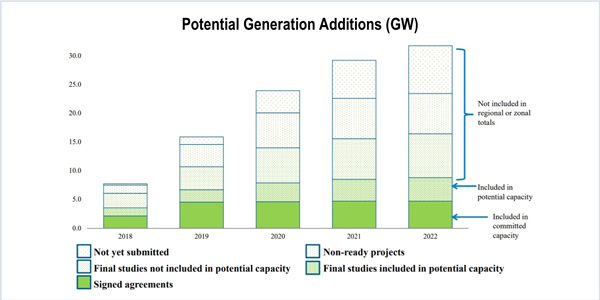By Amanda Durish Cook
In two orders issued on the same day last week, FERC both vacated and reinstated MISO’s entire resource adequacy construct, ultimately leaving the RTO’s current capacity auction format — and past auction results — undisturbed.
FERC’s two Feb. 28 decisions concurrently reversed its 2012 acceptance of MISO’s resource adequacy rules (ER11-4081) and accepted the RTO’s refiling of the rules (ER18-462).
To protect its market from “potential disruptions,” MISO in December pre-emptively refiled its entire resource adequacy construct in response to the D.C. Circuit of Appeals’ ruling that FERC overstepped its “passive and reactive” role when it prescribed revisions to PJM’s minimum offer price rule. MISO was concerned about the impact of that decision on some of the resource adequacy rules that had been guided by FERC’s recommendations. (See MISO Seeks FERC Reapproval to Keep RA Rules Intact.)
Following the PJM decision, the D.C. Circuit granted FERC a voluntary remand to once again consider MISO’s 2011 market revisions.
In the order on remand, FERC said in light of the court’s PJM decision, “the modifications set out in the [resource adequacy orders] could be considered to be major modifications to MISO’s 2011 filing. Accordingly, because we cannot find MISO’s 2011 filing to be just and reasonable without our modifications, we reverse the commission’s conditional acceptance of MISO 2011 filing, and we reject MISO’s 2011 filing in its entirety.”
FERC at that time rejected MISO’s proposed mandatory auction requirement and minimum offer price rule and ordered the RTO to phase out grandmother agreement provisions after the 2014/15 auction. Taken together, the revisions “would likely be considered to result in an ‘entirely different rate design’ than both MISO’s proposal and MISO’s prior rate scheme,” FERC said, acknowledging it had exceeded its authority under the Federal Power Act, “notwithstanding that MISO consented to those revisions.”
No Auction Do-Overs
However, FERC found that rerunning the last five years of MISO’s Planning Resource Auction under the pre-2011 monthly auction rules would be infeasible and unnecessary.
“Such a remedy would be extremely complex, subject to controversy and further litigation, and cause significant disruptions and burdens,” the commission said. “It would be highly difficult, if not impossible, for the commission or MISO to reasonably provide retroactive relief, by rerunning the auction for the 2013/14 planning year through the present.”
The commission then addressed MISO’s refiling, determining that the RTO’s current auction format should remain unchanged.
MISO Independent Market Monitor David Patton used the refiling as an opportunity to again urge FERC to order the RTO to employ a sloped demand curve in its capacity auction in order to produce more efficient pricing. (See MISO Monitor to FERC: Order Sloped Demand Curve.)
But the commission said MISO’s vertical curve was just and reasonable, noting that 90% of load is served by vertically integrated utilities. It said that, at any rate, pricing takes a backseat to the main objective: maintaining reliability.
“We … disagree with the Market Monitor’s contention that a vertical demand curve leads to prices that are not just and reasonable by failing to recognize the diminishing marginal benefits of excess capacity. MISO’s resource adequacy construct was developed to ensure that [load-serving entities] in MISO acquired sufficient capacity each year to maintain the one-day-in-10-year reliability standard. Although certain constructs may value capacity beyond that amount, doing so is not essential to MISO’s construct fulfilling this principal objective,” the commission said.
MISO maintains that its vertical demand curve and its annual resource adequacy survey with the Organization of MISO States “combine to provide just and reasonable signals.”
The commission also dismissed several other protests from stakeholders, including complaints that supply offers above $25/MW-day (about 10% of MISO’s cost of new entry) are read as an attempt to exercise market power under current capacity auction rules and that LSEs participated in price suppression in the 2017/18 auction.
FERC instead said that 2017/18’s low clearing price of $1.50/MW-day should be taken as the simple effect of supply and demand in MISO.
“The low capacity prices, where they have arisen in MISO, accurately reflect MISO’s capacity surplus. The fact that prices have not signaled to independent generators a need to build, retrofit or even simply maintain existing resources is more indicative of a well-functioning capacity procurement construct than it is of an unjust and unreasonable construct,” the commission said.




